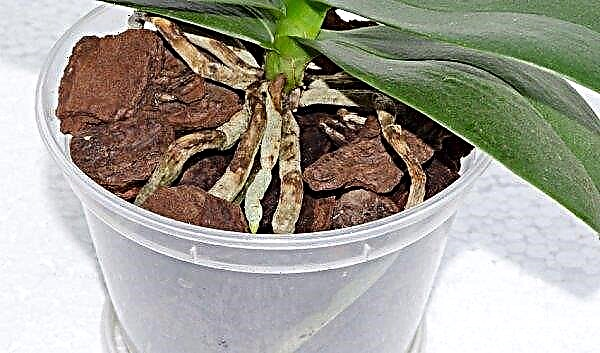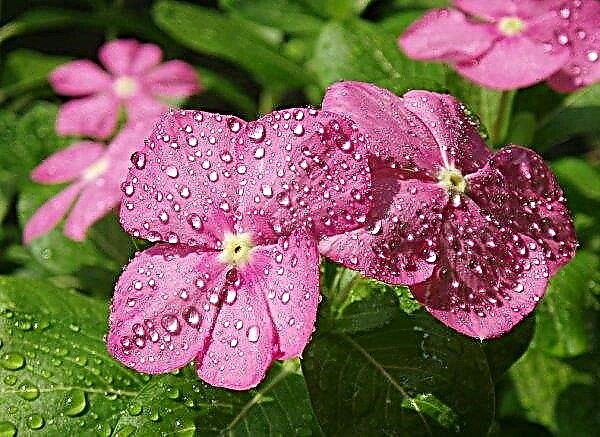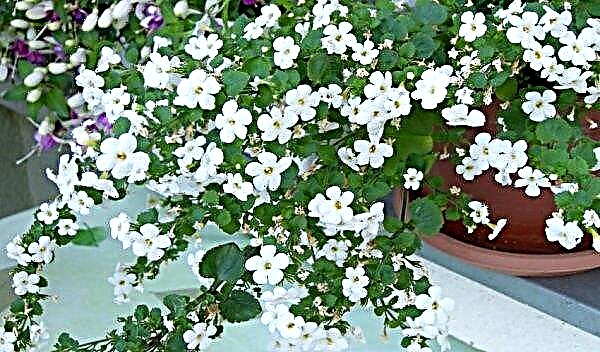Concrete is one of the most durable building materials. But its gray color may seem cold and unattractive. Fortunately for homeowners, it is also quite versatile and can easily be changed, improved, repainted and even decorated with various patterns. Read more about how and how to paint a concrete walkway in the country, read the article.
The choice of paint and its color
Despite its high strength and excellent performance, concrete does not have high decorative properties. This can be corrected by coloring. An additional function of the paint will be to protect the surface from moisture. But before painting, it remains to be decided which material to choose.
Important! DFor painting concrete, it is necessary to allocate about a week of time, since the general process includes cleaning the surface, removing old paint, sealing and priming. ATAll these work must be done before painting concrete.
A feature of concrete is that it easily absorbs water, and accordingly, it can expand and contract. Therefore, materials that contain elastic binder components and can taper along with the concrete texture are suitable for staining.
The modern market offers the following varieties of colored paint for concrete coatings:
- epoxy;
- vinyl;
- polyurethane;
- water emulsion;
- rubber.
 When choosing a color, you need to consider that light tones make the space visually larger and darker tones make it smaller. Color should also be in harmony with the general color scheme of your garden or summer cottage. Designers consider acceptable the use of 3-5 colors on the site. If there are more, it gives the territory a cluttered look.
When choosing a color, you need to consider that light tones make the space visually larger and darker tones make it smaller. Color should also be in harmony with the general color scheme of your garden or summer cottage. Designers consider acceptable the use of 3-5 colors on the site. If there are more, it gives the territory a cluttered look.
Video: how to paint a garden path
Epoxy
Traditionally, epoxy coatings are used on concrete surfaces. It forms a protective layer that allows the track to be used at high loads without any damage to its appearance. This strength is achieved due to the large amount of resinous substances in the paint. The processed alley will last at least 8 years without the need for repairs.
Did you know? People have used concrete since ancient times. Back in 6500 BC Bedouin merchants living in the territory of modern Syria have developed a concrete-like material, which was used for the construction of underground reservoirs.
This coating is based on a mixture of two separate components:
- epoxy resin;
- hardener.
Unlike ordinary paint, this composition hardens and does not dry out. As a result, the pores of concrete are sealed, enveloping the coating with a protective film, which protects the surface from stains, stains and scratches. The resin used in it gives the surface a shine. Various shades are available for sale: from metallic blue to cream and neutral gray. Consumption of material - 0.25 kg / m². The number of recommended layers is two. Drying time is 12-24 hours per coat. Epoxy coating is considered the most scratch resistant.
Various shades are available for sale: from metallic blue to cream and neutral gray. Consumption of material - 0.25 kg / m². The number of recommended layers is two. Drying time is 12-24 hours per coat. Epoxy coating is considered the most scratch resistant.
Suitable for use on:
- heavy traffic areas;
- automobile sites;
- driveways;
- garden areas with a lot of moisture;
- in pools, saunas, garages.
Compared to the cost of facing tiles, epoxy paint is much cheaper. The only drawback of such a coating is that it may turn yellow over time. The degree of yellowness depends on how transparent the resin is and how much it has been exposed to sunlight.
Acrylic
Acrylic concrete paints have a peculiar composition based on resins with the addition of various polymers. They can be matte, glossy and semi-gloss. Acrylic paint, like epoxy, creates a protective layer, quite durable and reliable, resistant to moisture and high temperatures.
Its technical characteristics:
- surface drying time lasts 30-60 minutes;
- moisture percentage - 0–10%;
- consumption - 1.2 kg / m².
Preparatory work is crucial in concrete painting. First, determine the moisture level on the track. To do this, firmly attach the plastic section to the concrete surface for 24 hours. If condensation forms under it, forget about the paint and use other processing methods. If the humidity is okay, then wash the track with a mild detergent. Oil or other stains that could not be removed are removed with hydrochloric acid and other, more intense means.
Important! You can use acrylic mixes on concrete slabs, but you must remember that they do not cope well with mechanical damage on a horizontal surface.
Acid etching will allow the dye to adhere to the surface better.. It is also advisable to repair any defects before painting the surface. Painting is not the only option for changing a concrete slab. Acrylic varnishes penetrate deep into concrete and create a translucent surface. They do not exfoliate and do not peel off like paint. Concrete varnishes are made to withstand abrasion and other factors, including ultraviolet rays, mechanical stress, and moisture. They are also available in different shades.
Rubber
Most products, called rubber paints, are made from synthetic rubber, but unlike latex emulsions, they form a thick protective coating. For example, Liquid Rubber forms a layer 20 mm thick.
Such paints create an elastic coating that provides:
- durability;
- moisture protection;
- extreme temperatures;
- chemical substances;
- sunshine;
- rust and shock.
They also provide isolation from vibration and reduce noise when used as a cover on a driveway.
Important! Please note that synthetic rubber paint is not compatible with other paints.
In addition, they are applied to:
- waterproofing coatings;
- roof tiles and gutters;
- facing of pools, ponds for fish;
- wooden or concrete surfaces, often in contact with water.
Some types of paints and varnishes may require the application of oil sealant before processing, so carefully read the instructions on the package and follow its instructions. Due to its composition, rubber paint is not just durable - it has high chemical resistance, which makes it ideal for agricultural and industrial use in areas where the paintwork must withstand the effects of acids, alkalis, wastewater and undergo severe wear. In addition, being an environmentally friendly material, such a coating has a minimal impact on the environment.. Rubber paints are available in several colors.
Due to its composition, rubber paint is not just durable - it has high chemical resistance, which makes it ideal for agricultural and industrial use in areas where the paintwork must withstand the effects of acids, alkalis, wastewater and undergo severe wear. In addition, being an environmentally friendly material, such a coating has a minimal impact on the environment.. Rubber paints are available in several colors.
Thanks to their components:
- harden in 20 minutes;
- can expand and contract depending on humidity, therefore they do not crack;
- maintain a temperature range from -50 ° C to + 60 ° C;
- have a saturated color;
- applicable for rooms without heating;
- serve up to 10 years;
- consumed in an amount of 0.4 kg / m².
They are characterized by excellent value for money.
Polyurethane
Polyurethane paint is an affordable, durable and highly effective way to protect a concrete surface. It enhances the color, giving it a glossy look, and also adds a protective, very durable coating for the track. Polyurethane substances can be used as a finishing coat on epoxy floors. The material quickly hardens and is suitable for use in a wide range of temperatures, and also provides protection from ultraviolet radiation.
Did you know? More than 7 billion cubic meters of concrete are produced annually in the world. This is 1 m³ for every person on the planet.
Technical features:
- flexible, very wear-resistant coating;
- the presence of shine;
- preservation of appearance even when in contact with abrasives - glass, sand, concrete;
- drying time - 2-12 days;
- material consumption - 200 g / m²;
- service life - 10-15 years.
 Despite the fact that there are many reasons why polyurethane paints are popular, they also have a number of disadvantages. They have such a thick composition that it must be applied in a very thin layer to avoid bumps and lumps. A thin layer will not cover defects of the underlying base, so it should be perfectly prepared. Otherwise, an epoxy primer should be applied and only then coated with polyurethane paint.
Despite the fact that there are many reasons why polyurethane paints are popular, they also have a number of disadvantages. They have such a thick composition that it must be applied in a very thin layer to avoid bumps and lumps. A thin layer will not cover defects of the underlying base, so it should be perfectly prepared. Otherwise, an epoxy primer should be applied and only then coated with polyurethane paint.
DIY staining steps
Before choosing a paint for a concrete track, it should be noted that, depending on the location and climatic zone, the temperature range should be taken into account for it. It determines the suitability of the selected type of coating. Do not experiment, hoping that inappropriate paint will hold. It will not last very long. Also think about the effect. There will be less scratches on the glossy finish, but spots will become noticeable on it.
The matte track is not so impressive at first glance, but looks longer like new and does not require as much care as glossy. Preparation for painting should be carried out in sunny weather. The concrete floor must be completely dry. Be sure to read the instructions on all materials purchased for work. Wash the track thoroughly with degreasing agent. Do this as many times as needed to make it completely clean. Let it dry well.
Staining steps include several steps:
- Remove old paint and smooth out any uneven areas. Remove any dust that has formed.
- If the surface has become roughened, make concrete mixture following the directions on the cement packaging. Fill any cracks and holes. Let it dry. If the surface is smooth, then go to the next step.
- Using a roller, apply two coats of primer. You need to let the track dry completely between the layers.
- Then, using a clean roller or compressor, apply 1-2 coats of paint. Drying time of each look on the packaging.

Concrete preparation
Before you start painting, remember that an unsatisfactory surface condition appears through a new layer. Cracks and other imperfections will attract attention, so they must be repaired.
Important! Be sure to use safety glasses, clothing, and gloves when handling concrete dust and acids.
Concrete preparation technology step by step:
- Clean any loose concrete with a wire brush.
- Remove debris with a vacuum cleaner and fill the cleaned cracks with new concrete.
- Smooth the surface with a hard putty.
- After the surface dries, sand the cracks with 100 grit sandpaper.
- To work with stains, use hydrochloric acid and a scraper with a durable high-carbon steel blade on an elongated handle to make it convenient to work.
- Remove rust using a solution for its removal, designed specifically for concrete masonry.
- In order for the paint to adhere better to the surface, degrease it. Apply according to the instructions on the label. Use a brush with hard bristles. Rinse off the surface with a garden hose.
The primer before painting will help ensure the quality of work and extend the life of the surface. Choose a primer that is compatible with both concrete and paint. After preparing the track, wait for it to dry completely before priming, since moisture will prevent the material from setting on the surface.
First use a brush to apply the substance on a curbstone or other type of edging. Then, using the roller, prime the remaining sheet. When applying a primer and paint, keep the “wet edge”, that is, do not let the borders of the painted area dry before processing the next one. This helps prevent visible roller marks on the finished track. After the primer has completely dried, apply the paint.
Paint application
If the paint consists of two components, like epoxy, then both parts must be mixed in accordance with the instructions on the label. Apply the emulsion in two layers in order to obtain a more abrasion resistant surface. Use a roller, brush or airless spray.
Did you know? The first concrete road was built in 1909. Up to this point, bricks, cobblestones or a mixture of resin and stones were used for laying.
Follow these guidelines:
- Do not work with paints and concrete at temperatures below + 5 ° C, above + 35 ° C and relative humidity above 70%.
- Do not paint if rain or frost is expected over the next 48 hours.
- Despite the fact that the surface will feel dry to the touch - keep the drying time specified by the manufacturer.
- Three weeks after painting, gently wash the concrete surface with a soft sponge and a colorless detergent.
With a brush
To stitch the seams between the individual plates, use a thin brush 2–5 cm wide. For larger areas, wider products are used. If a drawing will be applied to the surface, it is convenient to make a template and paint by applying it to the surface. If you need to give the texture of decorative stone, then you can mark the boundaries of the picture with masking tape. It is glued to the surface, and after drying, the paint is removed.
If you need to give the texture of decorative stone, then you can mark the boundaries of the picture with masking tape. It is glued to the surface, and after drying, the paint is removed.
Paint sprayer
There are pneumatic and manual sprayers. The difference between the two is that the first uses an air compressor, and the second needs to be pumped out periodically to keep the air pressure high enough to spray. The nozzle of the device should be adjusted so as to provide the best result when applying a “strip” with a width of 30 to 45 cm, although it can be adjusted. The optimal distance to the surface on which you want to hold the sprayer is the same - from 30 cm. Always make movements across the entire width of the surface in one row, and then add another layer on top of the second, which slightly overlaps the first. Continue across the path row by row until you are done.
The optimal distance to the surface on which you want to hold the sprayer is the same - from 30 cm. Always make movements across the entire width of the surface in one row, and then add another layer on top of the second, which slightly overlaps the first. Continue across the path row by row until you are done.
Using roller
Properly selected rollers will help save time. They come in different sizes and are designed for all surfaces. Each roller consists of a frame with a handle. Its length should be about 30 cm. A longer one will quickly tire a hand. A cylinder of porous material is worn on the frame. It is made of foam rubber or velor.
Important! One layer of paint is never enough to get the desired result, so apply the number of layers recommended by the manufacturer.
A roller with natural fiber bristles is best used with oil paints and varnishes, while synthetic ones will work well with latex mixtures. The latter retain their shape and rigidity well, regardless of how much moisture they absorbed. For concrete, it is advisable to choose a model with a pile length of 1.2–1.5 cm. The shorter length is intended for applying thin layers of paint on smooth surfaces (for example, wood). Most often, conventional submersible models are used for work.
But rollers with:
- piston system for supplying paints and varnishes;
- automatic feed system.
 The work technique includes the following actions:
The work technique includes the following actions:
- Masking tape is pasted over that part of the surface that should not be painted.
- In order to evenly distribute the coloring material, the immersion roller is lowered into the paint and rolled on a special corrugated pallet.
- Then make a border along one edge of the track.
- Next, a smear is performed along this border, partially overlapping it. And so they continue along the entire length (paint should be applied towards the light).
- Each subsequent layer is imposed only after the time for drying the previous one is sustained.
- After work, the foam rolls are discarded, and those that can be used several times are soaked in kerosene or another solvent. And then they put it into storage in a heated room.
Did you know? Roman builders mixed lime, water and volcanic ash from Mount Vesuvius, calling the resulting material “pozzolana”. In fact, it was one of the predecessors of modern concrete.
Safety precautions
As with any job, simple safety precautions should be followed. Coating should be done in workwear, protecting hands and face from paint, acids and other solutions.
You also need to remember a few simple recommendations:
- When removing old paint, use a respirator. Before, coloring materials with the presence of lead were often used - their dust is harmful to health.
- Collect garbage during processing in a closed container.
- For work, use a mixture with an effective shelf life.
- The paint remaining after completion of work should be kept tightly closed in a room with a temperature not lower than + 12 ° С.
- If paint gets on your skin, be sure to rinse it off with a cotton pad soaked in a solvent or sunflower oil.
The advantages of a painted track
Of all the materials that can be used for garden paths, concrete is one of the most attractive. Creating such a track is cheap, fast and practical.
- Among its advantages:
- strength - no need to worry about surface wear;
- environmental friendliness;
- ease of maintenance - just wash the track with water and use a sealant and wax every few months to refresh the look;
- durability - the material is resistant to intense wear, moisture, acids, the sun;
- design freedom - it is easy to repaint it or give it any texture.
Concrete can be painted at the stage of creating the track by adding pigment to the solution, or after hardening with various paints. The coloring technology is developed to such an extent that more shades are available for your choice than when painting wood. Smooth concrete can be textured if desired. It can be given the appearance of pavers, slate, stone slab or even wood. In addition, you can create seams on the concrete floor to create “blocks”, patterns or other textures. Combining the panel pattern with varnish will give the floor a marbling effect.
Smooth concrete can be textured if desired. It can be given the appearance of pavers, slate, stone slab or even wood. In addition, you can create seams on the concrete floor to create “blocks”, patterns or other textures. Combining the panel pattern with varnish will give the floor a marbling effect.
It is believed that the best option for staining is epoxy paint, as it retains its original appearance for longer. However, the needs of each garden path are unique and depend on the climate, humidity level and the desired results - this is what you need to remember when choosing.












